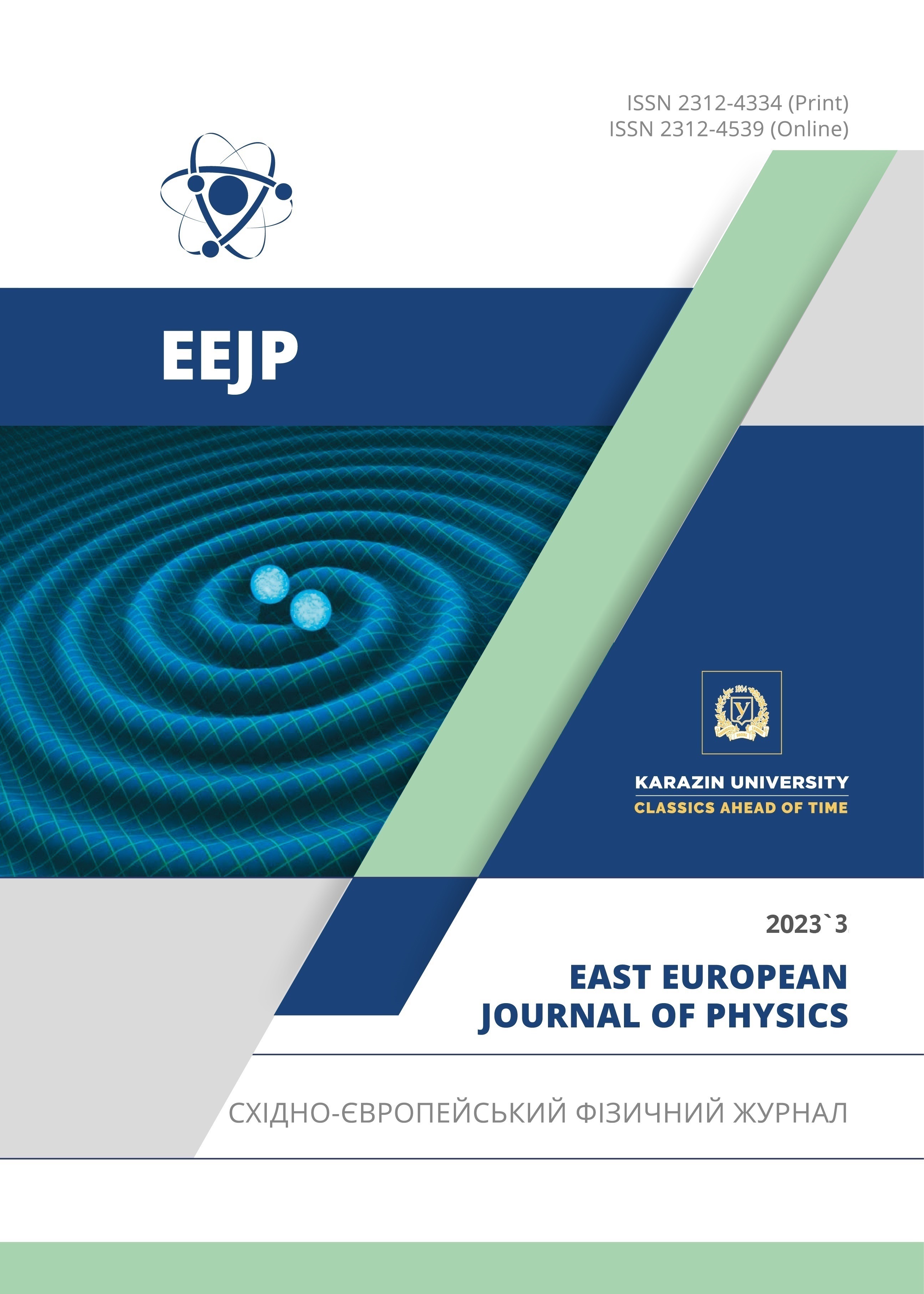Energy Conditions with Interacting Field in f(R) Gravity
Abstract
In the context of current scenario, it is crucial to look beyond Einstein’s theory, which opens the door to certain modified theories of gravity. So, present study is devoted to investigate the various energy conditions, particularly, strong energy condition (SEC), weak energy condition (WEC), null energy condition (NEC) and dominant energy condition (DEC) corresponding to different functional forms of f(R) gravity. We have studied for flat, isotropic and homogeneous FLRW cosmological model filled with interacting field i.e., perfect fluid is coupled with mass less scalar field for different models of modified f(R) gravity in which R is the Ricci scalar. We have observed, the accelerated expansion of the Universe which exact match with recent observational evidences.
Downloads
References
A.G. Riess, et al., Astron. J. 116, 1009 (1998). https://doi.org/10.1086/300499
S. Perlmutter, et al., Astrophys. J. 517, 565 (1999). https://doi.org/10.1086/307221
C.L. Bennet, et al., Astrophys. J. Suppl. 148, 1 (2003). https://doi.org/10.1086/377253
A.G. Riess, et al., Astrophys. J. 607, 665 (2004). https://doi.org/10.1086/383612
D.J. Eisenstein, et al. Astrophys. J. 633, 560 (2005). https://doi.org/10.1103/RevModPhys.75.559
P. Astier, et al., Astron. Astrophys. 447, 31 (2006). https://doi.org/10.1051/0004-6361:20054185
T. Padmanabhan, Phys. Rept. 380, 235 (2003). https://doi.org/10.1016/S0370-1573
P.J.E. Peebles, and B. Ratra, Rev. Mod. Phys. 75, 559 (2003). https://doi.org/10.1103/RevModPhys.75.559
S. Nojiri, and S. Odintsov, Phys. Rev. D, 68, 123512 (2003). https://doi.org/10.1103/PhysRevD.68.123512
R. Femaro, and F. Fiorini, Phys. Rev. D, 75, 084031 (2007). https://doi.org/10.1103/PhysRevD.75.084031
S. Nojiri, S. Odinstov, and P. Tretyakov, Prog. Theor. Phys. Suppl. 172, 81 (2008). https://doi.org/10.1143/PTPS.172.81
T. Harko, F.S.N. Lobo, S. Nojiri, and S.D. Odintsov, Phys. Rev. D, 84, 024020 (2011). https://doi.org/10.1103/PhysRevD.84.024020
H.A. Buchadahl, Mon. Not. Roy. Astron. Soc. 150, 1 (1970). https://doi.org/10.1093/mnras/150.1.1
S. Nojiri, and S.D. Odintsov, Int. J. Geom. Meth. Mod. Phys. 4, 115 (2007). https://doi.org/10.1142/S0219887807001928
T. Multamaki, and I. Vilja, Phys. Rev. D, 74, 064022 (2006). https://doi.org/10.1103/PhysRevD.74.064022
T. Multamaki, and I. Vilja, Phys. Rev. D, 76, 064021 (2007). https://doi.org/10.1103/PhysRevD.76.064021
M.F. Shamir, Astrophys. Space Sci, 330, 183 (2010). https://doi.org/10.1007/s10509-010-0371-5
M. Sharif, and H.R. Kausar, Phys. Lett. B, 697, 1 (2011). https://doi.org/10.1016/j.physletb.2011.01.027
M.F. Shamir, Int. J. Theor. Phys. 50, 637 (2011). https://doi.org/10.1007/s10773-010-0587-8
K.S. Adhav, Bulg. J. Phys. 39, 197 (2012). https://www.bjp-bg.com/papers/bjp2012 3 197-206.pdf
M.F. Shamir, and Z. Raza, Can. J. Phys. 93, 1 (2015). https://doi.org/10.1139/cjp-2014-0338
S.D. Katore, S.P. Hatkar, and R.J. Baxi, Found. of Phys. 46, 409 (2016). https://doi.org/10.1007/s10701-015-9970-x
S.R. Bhoyar, V.R. Chirde, and S.H. Shekh, Prespacetime J. 7(3), 456 (2016). https://prespacetime.com/index.php/pst/article/viewFile/915/907
M.V. Santhi, V.U.M. Rao and Y. Aditya, Can. J. Phys. 96, 1 (2017). https://doi.org/10.1139/cjp-2017-0256
A.V. Astashenok, S.D. Odintsov, and A. Cruz-Dombriz, Class. Quantum Grav. 34, 205008 (2017). https://doi.org/10.1088/1361-6382/aa8971
M.V. Santhi, Y. Sobhanbabu, and B.J.M. Raoz, J. Phys.: Conf. Ser. 1344, 012038 (2019). https://doi.org/1088/1742-6596/1344/1/012038
A.H. Hasmani, and A.M. Al-Haysah, Appl. Appl. Math, 14, 334 (2019). https://digitalcommons.pvamu.edu/cgi/viewcontent.cgi?article=1717andcontext=aam
S.D. Katore, and S.V. Gore, J. Astrophys. Astr. 41, 12 (2020). https://doi.org/10.1007/s12036-020-09632-z
A.M. Al-Haysah, and A.H. Hasmani, Heliyon, 7(9), e08063 (2021). https://doi.org/10.1016/j.heliyon.2021.e08063
V.U.M. Rao, M.V. Santhi, and Y. Aditya, Prespacetime J. 6(6), 531-539 (2015). https://prespacetime.com/index.php/pst/article/download/749/752
D.D. Pawar, V.J. Dagwal, and P.K. Agrawal, Malaya J. Mat. 4(1), 111 (2016). https://www.malayajournal.org/articles/MJM16 14.pdf
G.K. Goswami, A. Pradhan, M. Mishra, and A. Beesham, New Astronomy, 73, 101284 (2019). https://doi.org/10.1016/j.newast.2019.101284
S.V. Lohakare, F. Tello-Ortiz, S.K. Tripathy, and B. Mishra, Universe, 8(12), 636 (2022). https://doi.org/10.3390/universe8120636
V.R. Patil, J.L. Pawde, and R.V. Mapari, IJIERT, 9, 4 (2022). https://dx.doi.org/10.17605/OSF.IO/QABKV
D.D. Pawar, D.K. Raut, and W.D. Patil, Pramana J. Phys. 96, 133 (2022). https://doi.org/10.1007/s12043-022-02364-5
S.N. Bayskar, D.D. Pawar, and A.G. Deshmukh, Rom. Journ. Phys. 54, 763 (2009). http://www.nipne.ro/rjp/2009 54 7-8.html
D.D. Pawar, and R.V. Mapari, J. Dyn. Systems and Geom. Theories, 20(1), 115-136 (2022). https://doi.org/10.1080/1726037X.2022.2079268
B. Saha, H. Amirhashchi, and A. Pradhan, Astrophys. Space Sci. 342, 257 (2012). https://doi.org/10.1007/s10509-012-1155-x
V.R. Chirde, and S.H. Shekh, The African Rev. Phys. 9, 0050 (2014). http://lamp.ictp.it/index.php/aphysrev/article/view/971/393
J. Satish, and R. Venkateswarlu, Bulg. J. Phys. 46, 67 (2019). https://www.bjp-bg.com/papers/bjp2019 1 067-079.pdf
V.J. Dagwal, and D.D. Pawar, Mod. Phys. Lett. A, 35(04), 1950357 (2020). https://doi.org/10.1142/S0217732319503577
S.P. Hatkar, P. Agre, and S.D. Katore, Ann. Appl. Sci. 1, 659 (2022). https://doi.org/10.55085/aas.2022.659
A. Raychaudhuri, Phys. Rev. 98, 1123 (1955). https://doi.org/10.1103/PhysRev.98.1123
S. Nojiri, and S.D. Odintsov, Int. J. Geom. Methods Mod. Phys. 4, 115 (2007). https://doi.org/10.1142/S0219887807001928
N.W. Halverson, E.M. Leitch, and Pryke et. al., Astrophys. J. 568, 38 (2002). https://doi.org/10.1086/338879
J. Ehlers, Int. J. Mod. Phys. D, 15, 1573 (2006). https://doi.org/10.1142/S0218271806008966
S. Mandal, P.K. Sahoo, and J.R.L. Santos, Physical Review D, 102(2), 024057 (2020). https://doi.org/10.1103/PhysRevD.102.024057
P.K. Sahoo, S. Mandal, and S. Arora, Astron. Nachr. 342, 89 (2021). https://doi.org/10.1002/asna.202113886
S.H. Shekh, V.R. Chirde, and P.K. Sahoo, Commun. Theor. Phys. 72, 085402 (2020). https://doi.org/10.1088/1572-9494/ab95fd
Copyright (c) 2023 Vasudeo Patil, Jeevan Pawde, Rahul Mapari, Pravin Bolke

This work is licensed under a Creative Commons Attribution 4.0 International License.
Authors who publish with this journal agree to the following terms:
- Authors retain copyright and grant the journal right of first publication with the work simultaneously licensed under a Creative Commons Attribution License that allows others to share the work with an acknowledgment of the work's authorship and initial publication in this journal.
- Authors are able to enter into separate, additional contractual arrangements for the non-exclusive distribution of the journal's published version of the work (e.g., post it to an institutional repository or publish it in a book), with an acknowledgment of its initial publication in this journal.
- Authors are permitted and encouraged to post their work online (e.g., in institutional repositories or on their website) prior to and during the submission process, as it can lead to productive exchanges, as well as earlier and greater citation of published work (See The Effect of Open Access).








